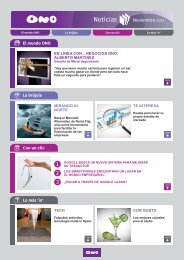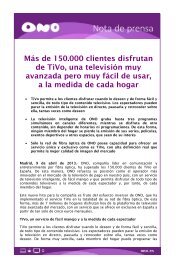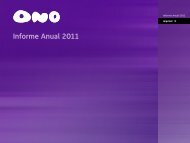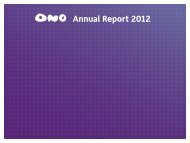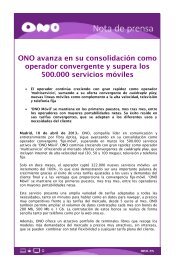Annual report (20-F) - Ono
Annual report (20-F) - Ono
Annual report (20-F) - Ono
You also want an ePaper? Increase the reach of your titles
YUMPU automatically turns print PDFs into web optimized ePapers that Google loves.
The chart below sets forth our organizational structure as of December 31, <strong>20</strong>04:<br />
Grupo Corporativo ONO<br />
RETECAL<br />
100%<br />
Cableuropa<br />
100%<br />
ONO Finance (Holdings) Ltd<br />
98%<br />
ONO Finance PLC<br />
2%<br />
Valencia<br />
100%<br />
Mediterranea Valencia Norte<br />
100%<br />
Mediterranea Valencia Sur Sur<br />
100%<br />
We are in the process of merging Valencia, Mediterranea Norte and Mediterranea Sur with<br />
Cableuropa. We are also in the process of merging Retecal with Cableuropa through a capital increase<br />
subscribed by GCO in exchange for 100% of the capital stock of Retecal.<br />
D. Property, Plant and Equipment<br />
Our Networks<br />
Local Networks<br />
Our local networks have been designed using a high-speed fiber-optic based system, capable of<br />
providing a full range of analog and digital services. The local networks are currently capable of<br />
supporting telephony, broadband Internet and cable television services. All of our services are provided<br />
through the same distribution system thus creating economies of scale. Fiber routing is designed to<br />
provide route diversity to the fiber junctions, or nodes, thereby protecting against loss of service resulting<br />
from cable damage.<br />
Our fiber-optic ring architecture is used to transport signals from local operations centers to<br />
primary nodes, or hub points, serving <strong>20</strong>,000 to 60,000 homes in urban areas. The local operations centers<br />
generally house both a cable television head-end and a telephony and data switch. The head-end<br />
assembles the cable television signals for transmission to the customers. The primary nodes are in turn<br />
connected to secondary nodes along a secondary fiber-optic ring network. These secondary nodes are<br />
optical distribution points each serving around 2,000 homes, which distribute fiber to the home terminal<br />
nodes. The home terminal nodes serve 500 homes.<br />
For telephony, the final points for distribution to homes and small businesses are cross-connect<br />
boxes from which the final connection to a customer’s home is made using twisted-pair copper wire. The<br />
terminal nodes transform the optical signals back into electrical format and transmit them onwards on<br />
coaxial cable or copper pairs to the customer’s premises. Cross-connect boxes are connected to the<br />
terminal nodes by twisted pair copper wire.<br />
Our 15 telephone switches are the core of our telephony business. Each switch is capable of<br />
handling up to 100,000 customers. The telephony network has been designed so that, as penetration and<br />
traffic increases, an incremental upgrade of the equipment will enable additional capacity to be easily<br />
provided at minimal cost. All the network’s telephony equipment is powered by battery backed-up power<br />
supplies, in order to meet the current legal requirement to provide at least 12 hours of service in the event<br />
of a power failure.<br />
For broadband Internet and cable television services, coaxial cables are used to transport the<br />
signals to homes, and amplifiers are used to boost the signal levels. Customer taps are used to serve<br />
individual dwellings. These typically serve four or eight homes per tap. Amplifiers are mounted in sealed<br />
units, generally on the façades of buildings. The final connection to the home, known as the drop, uses a<br />
combination of coaxial and copper pair cable. The coaxial part carries the broadband and cable television<br />
signals both to and from the homes. Two copper pairs are also incorporated in each drop to allow for<br />
44





